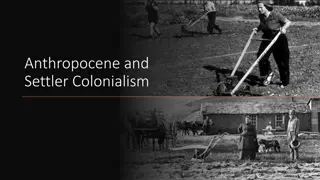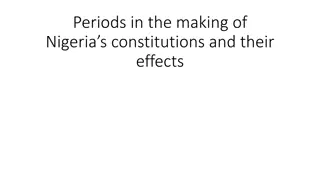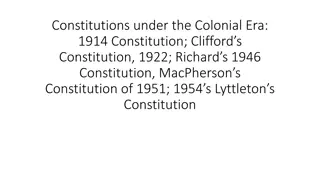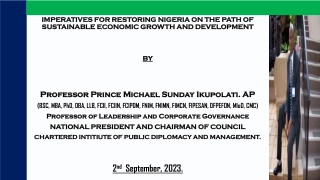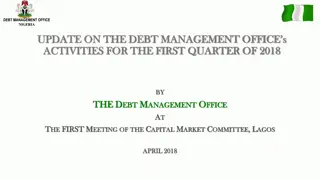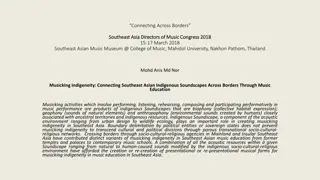Indigenous Economy of Pre-Colonial Nigeria
The indigenous economy of pre-colonial Nigeria was characterized by agriculture, local industries, crafts, trade, and services. Agriculture was the primary activity, with various crops grown and other occupations like hunting and fishing. Local industries included weaving, pottery, blacksmithing, and more, while trade was significant both locally and through long-distance exchanges, contributing to the development of states and empires in the region.
Download Presentation

Please find below an Image/Link to download the presentation.
The content on the website is provided AS IS for your information and personal use only. It may not be sold, licensed, or shared on other websites without obtaining consent from the author. Download presentation by click this link. If you encounter any issues during the download, it is possible that the publisher has removed the file from their server.
E N D
Presentation Transcript
GSP 2204 FOUNDATION OF NIGERIAN CULTURE, GOVERNMENT AND ECONOMY THE NIGERIAN ECONOMY BY Dr. BELLO ADO
Indigenous (pre-colonial) Economy of Nigeria Before the coming of colonial masters there was nothing called Nigeria, we had only Communities and ethnic groups like the Hausa, the Igbo, the Yoruba, the Nupe, the Jukun, the Ibibio, Ijaw Kanuri, Fulani, Efic, Tiv, etc. The indigenous pre-colonial Nigerian economy consisted of agriculture, local industry and crafts, trade and services. AGRICULTURE IN PRE-COLONIAL ECONOMY It was the basic pre-colonial activity with the pattern of specialization dictated by ecology and culture. crude implements, such as hoes, cutlass, sickles, etc. were used. The principal articles of food grown were guinea corn, millet, beans of several varieties, yam of various species, sweet potatoes, pepper of various kind, kola nuts and vegetables of all sorts, cotton, etc. Other pre-colonial occupations that were related to farming were hunting, fishing and pastoralism A very important aspect of economic importance of a hunter, during pre- colonial period was killing elephants whose tusks were ivory
Indigenous (pre-colonial) Economy of Nigeria CONTINUOUS Local industries and crafts in pre-colonial period It is certainly difficult if not impossible to discuss fully all works of art and crafts which pre-colonial Nigerians engaged in. Natural and geographical factors dictated the art and craft activities which pre-colonial Nigerian people engaged in Some of the activities they engaged in were basket and mat weaving, cloth making, pottery, blacksmithing, beer brewing, soap making industry and leather industries woodwork, etc. Closely associated with the leather industry was hide and skin industry, which had a separate market of its own.
Indigenous (pre-colonial) Economy of Nigeria CONTINUOUS Trade in Pre-Colonial Period Local Trade The exchange of goods in various parts of Nigeria has been of long standing. most early exchanges were the results of surplus production over and above the subsistence level. Local markets were organized at regular intervals of three, five or seven days and occasionally fortnightly, for the exchange of products. The organization of such markets gave the people the opportunity to sell local products at regular intervals. A sense of specialization soon grew. Items of local exchange included foodstuffs and household materials such as, pottery and soap. These markets also developed as the central markets for local products such as palm oil, which had begun to attract the European merchants. In many of the communities, different markets were established for locally produced and foreign goods to encourage local production as well as to attract long distance traders from other areas.
Indigenous (pre-colonial) Economy of Nigeria CONTINUOUS Foreign Trade (Long Distance Trade) Long distance trading activities principally contributed to emergence, growth and sustenance of states and empires that controlled the different parts of the Nigerian area during the pre-colonial era. There were also trans-saharan trades to countries of North Africa, Nile Valley region and southern Europe as well as transnational trade to neighbouring countries, including communities located in present day Cameroun, Republic of Benin, Togo, Niger and Chad. From the Sixteenth century, there developed trans-Atlantic trade to countries of South and Latin America, and later to Western Europe. The discovery of Kolanut in commercial quality in the Yoruba countries of south-western Nigeria as well as the Asante forest of present day Ghana subsequently led to the development of long distance trading activities between the trading cities of Northern Nigeria and Badagry in the Southwest and Gonja in the Asante forest of Ghana.
Indigenous (pre-colonial) Economy of Nigeria CONTINUOUS Around fifteen century Portuguese and British came to West Africa, this made trade to expand to Europe and America. The Portuguese were the first Europeans to come to West Africa. In 1485 there was a trade link between Portuguese and Kingdom of Benin. At first the Portuguese imported from West Africa pepper, Ivory and gold, the Portuguese started the Atlantic slave trade during the fifteen century, and this attracted many other European nations to West Africa. After Portuguese, English people found their way into West Africa despite the resistance by Portuguese. By middle of the Seventeenth century, more English traders became interested in the West African trade, particularly in the slave trade. For a long period, European contact with West Africa was confined to the coastal areas. The West African Chiefs and their peoples served as meddle men between local people and Europeans in trading.
Indigenous (pre-colonial) Economy of Nigeria CONTINUOUS Currencies and Transport during Pre-colonial period Initially trade by barter was adopted as a system of exchange. it suited the predominantly subsistence economy of the country before the advent of foreign trade. As a result of foreign trade a number of commodity-currencies and foreign coins found their way into Nigeria. In Nigeria, the cowry was the most generally accepted currency; the adoption of other commodity-currencies was restricted to local areas; Other currencies included Brass rodes, Manila, Copper wires, iron rods, Cloth and Salt. In addition to these commodity-currencies, there were a number of foreign coins which were real currencies in their respective countries. The modern transportation facilities such as tarred roads, railways, air transport were non-existent during pre-colonial era in Nigeria. The most widely modes of transportation in that period were human portage, donkeys, camels, horses and ox in the northern part and canoes which were used in natural water ways-the rivers in the southern parts and few areas in the north along the Niger and the Benue
Indigenous (pre-colonial) Economy of Nigeria CONTINUOUS The Fiscal System in pre-colonial era The natural rulers devised various means of raising adequate revenues for running their respective administrations. Revenues were collected in kind, mainly in foodstuffs, and provided for the rulers and their officials. The gradual adoption of a few commodity currencies, e.g iron rods, bracelets, manilas and cowries, simplified to some extent the payment of taxes. The structure and organization of the indigenous tax systems varied from one part of the country to another. In some well organized areas of Northern Nigeria the principal taxes included the Zakka or tithe on corn, the Kudin kasa or land tax, the plantation tax on all crops, the jangali or cattle tax and the Sokoto Gaisuwa a varying sum, paid chiefly in horses and slaves by all other emirates to Sokoto and Gwandu. Lastly there was the death duty (Gado), which passed the estate of the deceased to the Emir when there was no recognized heir In southern Nigeria, a large rudimentary indigenous tax system existed. In most of the Yoruba Kingdoms tax assessment were based on the ability to pay.
COLONIAL ECONOMY OF NIGERIA The colonial economy in Nigeria, like most of the other African countries was the one designed to serve the interest of the colonialists. The dominant motives of colonialism were the search for cheap raw materials and expansion of market for the products of the colonialists. To achieve these objectives, the colonial government developed a number of policies in different sections of the economy. Agriculture and Tax Policies the colonial government, through so many devices, discouraged the production of food crops while encouraged cash crop production. The raw materials which British needed included cotton for British textile factories, rubber for tyres and other products, palm oil and kernel for soap and margarine, groundnut for manufacturing oil, hides and skins for leather products, timber for furniture as well as tin, coal, among others. Introduction of tax. People produced more cash crops in order to earn more money to meet their tax obligation. The desire was to avoid penalties for the inability to meet up with their tax obligation
COLONIAL ECONOMY OF NIGERIA continuous.. Marketing board were established to buy these cash crops cheaply from local farmers and sell them at higher prices in international markets. Banking and Currency A new and common currency was introduced to replace the different currencies circulating in various part of the country. the government through Native Administration Insisted that taxes be paid in colonial currency. Government paid its soldier as well as other (suppliers, contractors and civil employees) In British minted coins The monetization of the Nigerian economy necessitated the establishment of Commercial Banks. Industrial and Trade Policies The economic interest of the colonialists also led them to avoid promotion of Industrial activities, particularly manufacturing, in order to protect the market for the products from their home country All local industries continued to operate, if only at a much reduced capacity. The increasing importation of foreign goods brought it new tastes for better and sometimes cheaper, industrial goods from Europe. This led to the death of many local industries.
COLONIAL ECONOMY OF NIGERIA continuous.. Multi-national firms established their firms in Nigeria. Transport Policy Development of transportation system in strategic places in order to ease evacuation of cash crop produce from hinterland to coastal areas and at the same time help in distributing imported British finished goods. Summary of Colonial Economic Policies Discouraging food crop production and encouraging cash crop production Establishment of marketing board which used to buy cash crop produce from local farmers at low price compared to its price in the world market Introduction of British currency in order to control the economy Introduction of tax in order to force the acceptance of British currency and force people to produce cash crops in order to get money to pay their tax Importation of cheap goods from Britain which later killed local industries. Development of transportation system in strategic places in order to ease evacuation of cash crop produce from hinterland to coastal areas and at the same time help in distributing imported British finished goods.
POST-COLONIAL ECONOMIC POLICIES Prior to 1986, a medium-term development plan was adopted as a major framework for developing and restructuring the economy. The first National Development Plan (1962-1968) It was developed to put the economy on the fast growth path. The plan gave adequate priority to agriculture and industrial development as well as training of high-level and intermediate manpower. Some of the achievements of the plan were construction of port-Harcourt oil refinery, Nigerian Minting, Jebba paper mill, Nkalagu Cement factory and Lagos port extension. The second National Development plan (1970-1974) It was launched primarily to reconstruct and rehabilitate infrastructure that had been damaged during the civil war. Thus the government invested a lot of resources into the construction and rehabilitation of infrastructure as well as improving the income of people. The third National Development Plan (1975-1980) It was designed under a more favourable financial condition because of the huge oil revenue that the country got from oil.
POST-COLONIAL ECONOMIC POLICIES CONTINUOUS .. The Fourth National Development Plan 1981-1985 It was affected by the collapse of the International Oil Price. With fall in revenue as a result of collapse of International oil prices and the economic crises that followed, the government was forced to reduce its participation in the economy drastically. the economic stabilization Act 1982 the government introduced this act with aim of exchange control, import restriction, as well as monetary and fiscal policies . The Austerity measure (1984) The basic idea of Economic Stabilization Act policy remained the same. the difference being an intensified implementation of stabilization policy measures including reduction from public expenditure, retrenchment, imposition of taxes and levies. Structural Adjustment Program (SAP) 1986 Same of the objective of SAP were To restructure and diversify the productive base of the economy. To achieve fiscal and balance of payment viability over the period
POST-COLONIAL ECONOMIC POLICIES CONTINUOUS .. To lay the emphasis for a sustainable minimum inflationary growth, and To reduce the government participation in the public sector, improve the sector s efficiency and intensify the growth potential of the private sector Among the policies of SAP were the following; Exchange rate adjustment through devaluation and deregulation of local currency Deregulation of interest rate to promote domestic savings and appropriate allocation of resources Privatization/Commercialization and Withdrawal of government subsidy The National Economic Empowerment and Development Strategy (NEEDS). (2004). The objectives of the programme were (i) Employment generation (ii) Wealth creation (iii) Poverty reduction and (ii) Value re-orientation. seven point agenda (2007) 1.Power and energy 2. Food security 3. Wealth creation 4. Transport sector 5. Land reforms 6. Security 7. Education
POST-COLONIAL ECONOMIC POLICIES CONTINUOUS .. Transformation agenda (2011). The priority sectors were 1. Power 2. The rehabilitation and expansion of national infrastructure 3. Agricultural development 4. Education and employment generation. The Economic Recovery and Growth Plan (2017-2020). The main objectives of the plan are; 1. Restore growth- to restore growth, the plan focuses on achieving macroeconomic stability and economic diversification. 2. Investing in our People-the plan will invest in people by increasing social inclusion, creating jobs and improving capital base of the economy. 3. Building a globally competitive economy. Despite all these structural adjustment programs and economic policies introduced from 1980 s to date. The Nigerian economy faces the following problem. The Nigerian economy is still mono-product economy with the bulk of government revenue coming from oil exports which is susceptible to shocks in the international market. Infrastructural challenges-the economy faces poor economic and social infrastructure- bad roads, erratic power supply limited access to portable water etc.
POST-COLONIAL ECONOMIC POLICIES CONTINUOUS .. Corruption-all sectors of the economy have submerged into the river of corruption Low quality education- low quality education as a result of poor funding, irrelevance of curricula to industrial needs. Poor investment climate. In the absence of poor infrastructural facilities the cost of doing business in the country remains high forcing firms transferring to neighbouring countries even companies that had existed in Nigeria for upward of four decades. Insecurity example, militancy in Niger Delta area, insurgency in the Northeast, human kidnapping and demanding for ransom, arm robbery etc.
OIL IN NIGERIA The Nigerian Petroleum Industry, at present, is generally believed to be the pivot of the Nigerian economy and the hub around which other sectors of the national economy revolve. revenue from oil and gas accounting for about 90% of the nation s foreign exchange and over 70% of revenue The first discovery of commercial quantities of oil in Nigeria was in 1956, with reserves estimated from sixteen to twenty two billion barrels mostly found in various fields in the costal regions of the Niger Delta. During the colonial period, it contribution was very little to the GDP or export of the country. However after independence, its contribution increased steadily. Production reached its climax in 1973, because of the Arab-Israel war when the Suez Canal was closed to traffic. Nigeria got a lot of Money during that period. In 1980 s the price of oil fell down as low as $8 per barrel as a result of oil glut. Also, Nigeria got a lot of money from oil as a result of Kuwait-Iraqi war in 1991
OIL IN NIGERIA CONTINUOUS.. Deregulation of Down Stream Sector of the Nigerian Petroleum. The Nigerian Petroleum Industry is divided into two sectors the upstream sector (which deals with exploration and production) and the downstream sector (which deals with refining, distribution and marketing of crude oil for domestic consumption. Nigerian government has deregulated the down stream sector .
AGRICULTURE IN NIGERIA Agriculture was the bedrock of the Nigerian economy during pre-colonial and colonial eras, even early period of independence. Before the production of oil in large quantity around early 1970s agriculture remained the mainstay of the Nigerian economy. Various programs were introduced to revamp agriculture in Nigeria some of which were the following: National Accelerated Food Production Programme (NAFPP) 1972 Operation feed the nation (OFN) 1976 River Basin Rural Development Authorities 1976 Green Revolution (1980) Back to Land (1984) Accelerated wheat production scheme (AWPP) 1987 National Fadama Development Project 1990 Agricultural Transformation Agenda (2011) The Green Alternative: Agricultural Promotion Policy (APP) (2016)
INDUSTRIAL/MANUFACTURING SECTOR IN NIGERIA Nigeria started its industrialization drive with import-substituting industrialization (ISI) strategy. The 1972 Act on indigenization of enterprises operating in Nigeria resulted in an indigenization policy which was consequently amended, repealed, and replaced by the Nigerian Enterprises promotion Act of 1977. The objectives of the policy were Transfer ownership and control to Nigerians in respect of these enterprises formerly owned (wholly or Partly) and controlled by foreigners. Foster widespread ownership of enterprises among Nigerian citizens. Create opportunities for Nigerian indigenous businessmen. Encourage foreign businessmen and investors to move from the unsophisticated spheres of the economy to domains where large investments are required. Nigerian Industrial Revolution Plan (NIRP) 2014 The plan was aimed at development of a competitive advantage in the industrial sector of the country
INDUSTRIAL/MANUFACTURING SECTOR IN NIGERIA CONTINUOUS .. The objectives of NIRP are; Boost competitive advantage Create jobs Maintain trade balance Increase the current GDP of 4% to 10% over the next five years. National Enterprise Development Programme (NEDEP) (2014) The NEDP program has been designed to address the challenges that are stifling the gross of the micro, small and medium enterprises in Nigeria The main objective of the program is to create a minimum of one million jobs annually by strengthening the existing MSMEs in the country and making them employers of labor and creating new and sustainable enterprises in the country.
INDUSTRIAL/MANUFACTURING SECTOR IN NIGERIA CONTINUOUS . Problems of Manufacturing/Industrial Sector in Nigeria Nigerian industrial sector faces following problems; Poor infrastructure Policy inconsistency Low industrial skills and innovation Inadequate metrology and standard Low patronage of made in Nigeria goods Naira depreciation makes cost of production high Escalation of interest rate Massive importation and smuggling of cheap goods The End




